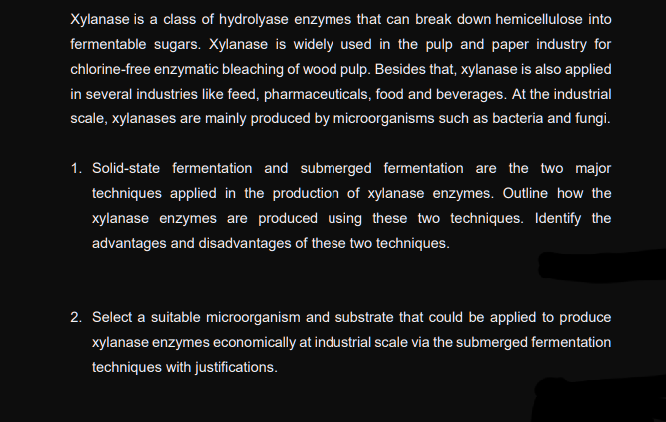Solid-state rmentatio submerged ermentation are two major the techniques applied in the production of xylanase enzymes. Outline how the xylanase enzymes are produced using these two techniques. Identify the advantages and disadvantages of these two techniques. 2. Select a suitable microorganism and substrate that could be applied to produce xylanase enzymes economically at industrial scale via the submerged fermentation techniques with justifications.
Solid-state rmentatio submerged ermentation are two major the techniques applied in the production of xylanase enzymes. Outline how the xylanase enzymes are produced using these two techniques. Identify the advantages and disadvantages of these two techniques. 2. Select a suitable microorganism and substrate that could be applied to produce xylanase enzymes economically at industrial scale via the submerged fermentation techniques with justifications.
Human Anatomy & Physiology (11th Edition)
11th Edition
ISBN:9780134580999
Author:Elaine N. Marieb, Katja N. Hoehn
Publisher:Elaine N. Marieb, Katja N. Hoehn
Chapter1: The Human Body: An Orientation
Section: Chapter Questions
Problem 1RQ: The correct sequence of levels forming the structural hierarchy is A. (a) organ, organ system,...
Related questions
Question

Transcribed Image Text:Xylanase is a class of hydrolyase enzymes that can break down hemicellulose into
fermentable sugars. Xylanase is widely used in the pulp and paper industry for
chlorine-free enzymatic bleaching of wood pulp. Besides that, xylanase is also applied
in several industries like feed, pharmaceuticals, food and beverages. At the industrial
scale, xylanases are mainly produced by microorganisms such as bacteria and fungi.
1. Solid-state fermentation and submerged fermentation are the two major
techniques applied in the production of xylanase enzymes. Outline how the
xylanase enzymes are produced using these two techniques. Identify the
advantages and disadvantages of these two techniques.
2. Select a suitable microorganism and substrate that could be applied to produce
xylanase enzymes economically at industrial scale via the submerged fermentation
techniques with justifications.
Expert Solution
This question has been solved!
Explore an expertly crafted, step-by-step solution for a thorough understanding of key concepts.
Step by step
Solved in 2 steps

Knowledge Booster
Learn more about
Need a deep-dive on the concept behind this application? Look no further. Learn more about this topic, biology and related others by exploring similar questions and additional content below.Recommended textbooks for you

Human Anatomy & Physiology (11th Edition)
Biology
ISBN:
9780134580999
Author:
Elaine N. Marieb, Katja N. Hoehn
Publisher:
PEARSON

Biology 2e
Biology
ISBN:
9781947172517
Author:
Matthew Douglas, Jung Choi, Mary Ann Clark
Publisher:
OpenStax

Anatomy & Physiology
Biology
ISBN:
9781259398629
Author:
McKinley, Michael P., O'loughlin, Valerie Dean, Bidle, Theresa Stouter
Publisher:
Mcgraw Hill Education,

Human Anatomy & Physiology (11th Edition)
Biology
ISBN:
9780134580999
Author:
Elaine N. Marieb, Katja N. Hoehn
Publisher:
PEARSON

Biology 2e
Biology
ISBN:
9781947172517
Author:
Matthew Douglas, Jung Choi, Mary Ann Clark
Publisher:
OpenStax

Anatomy & Physiology
Biology
ISBN:
9781259398629
Author:
McKinley, Michael P., O'loughlin, Valerie Dean, Bidle, Theresa Stouter
Publisher:
Mcgraw Hill Education,

Molecular Biology of the Cell (Sixth Edition)
Biology
ISBN:
9780815344322
Author:
Bruce Alberts, Alexander D. Johnson, Julian Lewis, David Morgan, Martin Raff, Keith Roberts, Peter Walter
Publisher:
W. W. Norton & Company

Laboratory Manual For Human Anatomy & Physiology
Biology
ISBN:
9781260159363
Author:
Martin, Terry R., Prentice-craver, Cynthia
Publisher:
McGraw-Hill Publishing Co.

Inquiry Into Life (16th Edition)
Biology
ISBN:
9781260231700
Author:
Sylvia S. Mader, Michael Windelspecht
Publisher:
McGraw Hill Education